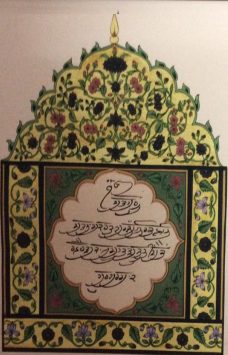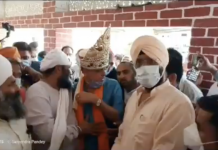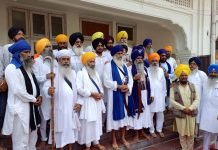Recently, a Gurdwara in Fresno (California), under the influence of Ragi Darshan Singh, has altered the first line of Ardas from the word “Bhagauti” to “Akal Purkh”. This isn’t the first time such a change has been made.
In 1928, Akal Takht Sahib excommunicated Teja Singh Bhasaur for changing bhagauti to Satnam. The rest of the Takhts then followed suit, and Teja Singh was effectively boycotted by the entire Panth. Teja Singh Bhasaur had doubts over core principles of the Sikh religion, including the arrangement of Banis in Guru Granth Sahib and the authenticity of Bhagat Banis. He also refuted that Vaheguru is the Gurmantar. By changing Ardas and casting doubts over banis, Ragi Darshan Singh seems to be actively promoting the anti-Panthik Bhasaur ideology.
The first line of Ardas is “Pritham Bhagauti Simar Ke, Guru Nanak Lae Dheaae” and comes from the epic titled “Chandi Di Vaar,” which is also known as “Vaar Sri Bhagauti Ji Ki” by Guru Gobind Singh Ji. This composition is based on a conflict between deities and the demons. Chandi (warrior goddess) comes to the rescue of Indra (king of heavens), who has his kingdom overtaken by the demons. The word bhagauti appears twice in the opening of Chandi Di Vaar. First stanza of Chandi Di Vaar is also the first part of the Sikh ardas. Critics of the word bhagauti associate it with the word bhagwati, which means goddess, and have been proposing to change it to “Pritham Akal Purakh Simar Ke”.
Gurbani is full of metaphors, and there are often several meanings for the same word. One has to see the complete context in order to fully understand its meaning. The word bhagauti appears 9 times in Guru Granth Sahib. In Sukhmani Sahib, the word bhagauti in ਭਗਉਤੀ ਭਗਵੰਤ ਭਗਤਿ ਕਾ ਰੰਗੁ refers to a devotee of Vaheguru. Similarly, in ਸੋ ਭਗਉਤੀ ਜੋੁ ਭਗਵੰਤੈ ਜਾਣੈ, the word bhagauti is referring to a devotee who understands Vaheguru through the Guru’s blessings. Bhai Gurdas Ji refers to bhagauti in the context of a sword. In his Vaar 25, Pauri 6, Bhai Gurdas Ji writes –
ਜਾਣੁ ਕਥੂਰੀ ਮਿਰਗ ਤਨਿ, ਨਾਉ ਭਗਉਤੀ ਲੋਹੁ ਘੜਾਇਆ।
The musk is found in the navel of deer and from ordinary iron the powerful sword is aced.
Bhai Kahn Singh Nabha, encyclopediast and author of several books on the Sikh religion, gives six different meanings to the word bhagauti in the Mahan Kosh (first Sikh encyclopedia). However, in the context of “Pritham Bhagauti Simar Ke,” he clearly defines bhagauti as Vaheguru. He has recorded the following meaning – “੫. ਮਹਾਕਾਲ. “ਪ੍ਰਿਥਮ ਭਗਉਤੀ ਸਿਮਰਕੈ.” (ਚੰਡੀ ੩)” This is relevant and significant, because Bhai Kahn Singh Nabha’s work is widely accepted throughout the Panth and used as a reference by scholars.
Prof. Sahib Singh, an academic and author of Sri Guru Granth Darpan, in his article titled “Guru Gobind Singh Ji and Devi Puja” writes, “Bhagauti certainly does translate to an iron sword. However, this raises the question – is Guru Gobind Singh Ji bowing to a sword in the opening stanza of Chandi Di Vaar? No, this is not the case. The idea is to present Akal Purakh as the creator and destroyer.” (Panj Daria, 1941).
“ਭਗੌਤੀ ਕੀ ਹੈ? ਲੋਹੇ ਦੀ ਬਣੀ ਹੋਈ ਤਲਵਾਰ ਹੈ।ਪਰ ਇਥੇ ਇਕ ਹੋਰ ਭੁਲੇਖਾ ਆ ਪੈਂਦਾ ਹੈ।ਕੀ ਸਤਿਗੁਰੂ ਜੀ ਇਥੇ “ਪ੍ਰਥਮ ਭਗੌਤੀ ਸਿਮਰਿ ਕੈ” ਵਿਚ ਤਲਵਾਰ ਨੂੰ ਨਮਸਕਾਰ ਕਰ ਰਹੇ ਹਨ? ਨਹੀਂ।ਜਿਵੇਂ ਬਚਿਤ੍ਰ ਨਾਟਕ ਵਿਚ ਵੇਖ ਆਏ ਹਾਂ, ਇਥੇ ਭੀ ਅਕਾਲ ਪੁਰਖ ਨੂੰ ‘ਭਗੌਤੀ’(=ਤਲਵਾਰ) ਨਾਮ ਦੇ ਕੇ ਉਸਦਾ ਭਿਆਨਕ ਰੂਪ ਵਿਖਾਇਆ ਹੈ।” (ਪ੍ਰੋ. ਸਾਹਿਬ ਸਿੰਘ)
This representation of Akal Purakh as the creater and destroyer appears frequently in Gurbani. For example: ਤੁਧੁ ਆਪੇ ਸ੍ਰਿਸਟਿ ਸਭ ਉਪਾਈ ਜੀ ਤੁਧੁ ਆਪੇ ਸਿਰਜਿ ਸਭ ਗੋਈ ॥ You Yourself created the entire universe, and having fashioned it, You Yourself shall destroy it all. (Guru Granth Sahib Ji, 11)
Giani Sant Singh Maskeen, a well-respected Sikh scholar, has interpreted the word bhagauti as ‘shakti’ (divine energy). This discourse is available on Youtube under the title “Pritham Bhagauti Simar Ke – Giani Sant Singh Ji Maskeen” in a five part series. In his katha, Maskeen Ji compares the battle between Chandi and demons as the fight between virtuousness and evil. Per Maskeen Ji, Chandi Di Vaar was narrated by Guru Gobind Singh Ji with the sole purpose of inspiring his followers to fight for righteousness –
ਦਸਮ ਕਥਾ ਭਾਗੌਤ ਕੀ ਭਾਖਾ ਕਰੀ ਬਨਾਇ ॥ ਅਵਰ ਬਾਸਨਾ ਨਾਹਿ ਪ੍ਰਭ ਧਰਮ ਜੁਧ ਕੇ ਚਾਇ ॥
I have composed the discourse of the tenth part of Bhagavat in the vernacular.
O Lord ! I have no other desire and have only the zeal for the war fought on the basis of righteousness.
Dr. Jaswant Singh Neki, a renowned poet and scholar, presents an alternative interpretation of the word bhagauti. In his article titled Bhagauti, he writes, “God had in Sikhism as in other major traditions by and large a masculine connotation. He had been called Purakh implying masculinity. Although at times he had been addressed as mata (mother) as well as pita (father), almost all the names employed for him in Sikh Scripture, the Guru Granth Sahib—Ram, Govind, Hari, Shiv, Allah, etc.—were only masculine names. To widen the conception, Guru Gobind Singh may have chosen Bhagauti, a name with a clear feminine implication.” He further adds, “The second archetypal significance of bhagauti is linked to its other lexical meaning ‘sword’ as exemplified by Bhai Gurdas. Bhagauti where prefixed with the honorific “Sri” (lid. fortunate, graceful) signifies the ‘Divine Sword’ –the Power that brings about the evolution and devolution of the Universe.” (Dr. JS Neki, Bhagauti, Patshahi10.org)
While deliberating the meaning of the word bhagauti, it’s important to consider the following points –
1) The opening stanza of ardas is “Ikongkar Sri Vaheguru Ji Ki Fateh” – this signifies Guru Gobind Singh Ji’s faith in Akal Purkh. Reference to Bhagauti subsequent to Vaheguru shows that it is referring to Akal Purkh.
2) Chandi Di Vaar’s first stanza makes it clear that the goddess is not the divine force (Shakti), rather, she is the creation of Akal Purkh –
ਤੈ ਹੀ ਦੁਰਗਾ ਸਾਜਿ ਕੈ ਦੈਤਾ ਦਾ ਨਾਸ ਕਰਾਇਆ ॥
O Lord! By creating Durga, Thou hast caused the destruction of demons
3) Further in Chandi Di Vaar, it’s written that as the battle between Durga and demons initiates, she picks up the bhagauti and pierces it through demon Shumb[a]’s body. This leaves no doubt that bhagauti is not a goddess, neither the same as Durga, but the divine energy instilled in the sword –
ਲਈ ਭਗਉਤੀ ਦੁਰਗਸਾਹਿ ਵਰ ਜਾਗਣਿ ਭਾਰੀ ॥ ਲਾਈ ਰਾਜੇ ਸੁੰਭ ਨੋ ਰਤ ਪੀਐ ਪਿਆਰੀ ॥
4) In the Bhagauti Astotar, Guru Gobind Singh Ji defines Bhagauti very clearly as he hails this divine energy.
ਨਮੋ ਸ੍ਰੀ ਭਗੋਤੀ ਬਢੈਲੀ ਸਰੋਹੀ। ਕਰੇ ਏਕ ਤੇ ਦਵੈ ਸਭਟ ਹਾਥ ਸੋਹੀ।
Hail the Supreme Sword that pierces through quickly. He who holds it becomes victorious as the sword splits one into two.



Some analysis of the word pritham in ਪ੍ਰਥਮਿ ਭਗਉਤੀ ਸਿਮਰ ਕੈ ਗੁਰੂ ਨਾਨਕ ਲਈ ਧਿਆਇ could help understand the concept of bhagauti as well. Pritham has been defined as “first, main, chief, highest or first in order” by Bhai Kahn Singh Nabha in the Mahan Kosh. Perhaps, Guru Sahib used it in the same context as Maha Kal – ਮਹਾਕਾਲ ਰਖਵਾਰ ਹਮਾਰੋ (Vaheguru who is destroyer of death is my protector. Chaupai Sahib). The word Maha here refers to the Supreme Being. So perhaps in Chandi Di Vaar’s opening stanza, pritham bhagauti could refer to the most superior or the highest shakti. This shakti of Vaheguru is shown through a sword like seal, sitting atop of the moolmantar in the featured image of this article.
Ardas is not just a prayer, but a source of inspiration for Sikhs. Ardas is the expedition of a Sikh from Vaheguru, the Guru Sahibs, 5 Pyare, 4 Sahibzade, countless gursikhs and martyrs, gurdwaras, takhts, etc. Through it, we relate to our history and ideology several times a day. We should take inspiration from our rich heritage, history, and traditions and preserve these for the generations to come.
Prabhdev Singh has Engineering and IT degrees and is overseeing several Khalis Foundation projects. He currently supervises the media and outreach division of Khalis Foundation. He is currently working for an IT company as a product manager and apart from this, he is also a founder and director of the West Coast Sikhi Camp.





What this painting for sale
Sikhs will not be carried way by opinions of individuals but they them selves will explore the TRUTH.
You want to change the truth but it will come back and hurt you
So it means that in chandi di war Bhaugati had multiple meanings and it is dependent on individual interpretation..
I guess we need to apply the simplest meaning of any word.
The desire to change the word also shows that people have a ulterior motives
One can pick up any word any line from anyplace and can twist the meaning to what the author is trying to prove. This is what Prabhdev Singh has done . He had clear idea what he wants to prove and he picked up lines to prove the same.But that doesn’t change the absolute truth.I have a question for Mr Prabhdev Singh and all the followers of Bachittar natak. Please guide me to the place where any of the material written in so called Dasam granth all 1428 pages is in the handwriting of Guru Gobind Singh ji.Right now all the technology exists that one can check handwriting and age of the papers to confirm who is right and who is wrong.Until that happens everything is just hearsay.Don’t tell me about Sodhak committee or the likes I am well aware of those.Again second question for these believers of bachittar natak is What did Guru Gobind Singh Ji do before leaving this world.He appointed Guru Granth Sahib ji as our Guru. Now the question arises what a Sikh is supposed to believe . The absolute truth as presented in Guru Granth Sahib ji or something written in some book based on hearsay.As far as Sikhs are concerned Bani is what is written in Guru Granth Sahib ji and nothing else. As far as Ragi Darshan Singh is concerned he has a point of view, don’t abuse him just prove him wrong if you cannot do it then you don;t have any right to condemn him.At least Darshan Singh has guts to admit to the whole world that he was wrong. It is really amazing here is a person who is following the order of Guru Gobind Singh Ji is being vilified and the persons who are bent on destroying our religion are being praised . May Waheguru bless us.
Rajinder can you tell us which of Sri Guru Granth Sahib’s 1430 angs are in Guru Sahib’s own hand-writing?
These culprits who try to change Bani ought to be boycotted by the Panth. Even Guru Har Rai Ji disowned his own son for changing one word of the Gurbani…. who are these people to criticise on what is the Word of Almighty. Disgraceful and not a Sikh……..whatever they may call themselves.
Ragi Darshan Singh, once a respected person, lost his mind, his lok & parlok in old age.